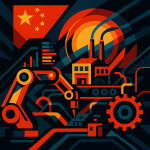Key Points
- China aims to become an education powerhouse by 2035, viewing education as fundamental to national rejuvenation and influence.
- The strategy emphasizes integrating education with science, technology, and talent development, aligning university disciplines with national needs and boosting basic research.
- Specific focus areas include cultivating top-tier innovative talents, improving vocational education to produce skilled craftsmen (大国工匠, 能工巧匠), and leveraging Artificial Intelligence (AI) for educational transformation.
- The plan aims for more inclusive and accessible public education services, promoting balanced compulsory education, supporting vulnerable children, and consolidating the Double Reduction Policy (双减).
- China is promoting educational opening up and aiming to enhance its global influence by fostering international cooperation and developing world-class institutions with Chinese characteristics.

China is embarking on an ambitious mission to accelerate the establishment of an education powerhouse, a strategic move with massive implications for tech, talent, and global influence.
This isn’t just talk; it’s a core national strategy.
A pivotal article by Xi Jinping (Xī Jìnpíng 习近平), General Secretary of the Communist Party of China, President, and Chairman of the Central Military Commission, titled “Accelerating the Establishment of an Education Powerhouse,” is set to be featured in the 11th issue of Qiúshì (求是) magazine, published on June 1st.
Let’s break down what this means for founders, investors, and tech enthusiasts watching China’s next moves.
The Vision: A Socialist Education Powerhouse with Chinese Characteristics
The article underscores a fundamental belief: education is the bedrock of a strong nation and essential for national rejuvenation.
Since the 18th National Congress of the Communist Party of China, the nation has prioritized education, aiming to build this powerhouse by 2035.
This isn’t just about more schools or students; it’s about creating a system with:
- Strong ideological and political guidance.
- Globally competitive talent.
- Cutting-edge scientific and technological support.
- Robust livelihood guarantees through education.
- Effective social synergy.
- Significant international influence.
Achieving this requires a multi-faceted approach, touching every level of education:
- Fostering Virtue and Cultivating Talent: Integrated ideological and political education.
- Basic Education: Ensuring equity and high quality.
- Higher Education: Developing self-reliant and excellent institutions.
- Vocational Education: Promoting deep industry-education integration.
- Lifelong Learning: Making it ubiquitous and accessible.
- Innovation Engine: Driving progress through scientific and technological support.
- Teacher Quality: Cultivating high-caliber teaching teams.
- Global Engagement: Facilitating open and reciprocal international cooperation.

Find Top Talent on China's Leading Networks
- Post Across China's Job Sites from $299 / role
- Qualified Applicant Bundles
- One Central Candidate Hub
Your First Job Post Use Checkout Code 'Fresh20'

- Fostering Virtue and Cultivating Talent: Integrated ideological and political education.
- Basic Education: Ensuring equity and high quality.
- Higher Education: Developing self-reliant and excellent institutions.
- Vocational Education: Promoting deep industry-education integration.
- Lifelong Learning: Making it ubiquitous and accessible.
- Innovation Engine: Driving progress through scientific and technological support.
- Teacher Quality: Cultivating high-caliber teaching teams.
- Global Engagement: Facilitating open and reciprocal international cooperation.
Navigating the Complexities: Key Relationships in Education Reform
Building an education superpower is a massive undertaking.
The article stresses understanding education’s political, people-centered, and strategic attributes.
Crucially, it means balancing:
- National strategy vs. individual needs.
- Knowledge acquisition vs. all-round development.
- Talent cultivation vs. societal demands.
- Regulation vs. stimulating vitality.
- Rooting education in China vs. learning from international experience.
The message is clear: this isn’t a “wait and see” situation. The 2035 goal is non-negotiable.

ExpatInvest China
Grow Your RMB in China:
- Invest Your RMB Locally
- Buy & Sell Online in CN¥
- No Lock-In Periods
- English Service & Data
- Start with Only ¥1,000

Priority #1: Steadfastly Fostering Virtue and Cultivating Talent
This is about shaping the next generation.
The plan involves strengthening ideological and political education in schools.
The goal? To guide young students to:
- Strengthen belief in Marxism, socialism with Chinese characteristics, and national rejuvenation.
- Aspire to serve the country and become capable, contributing citizens.
Key actions include:
- Persistently using the “thought on socialism with Chinese characteristics for a new era” to educate.
- Synchronizing ideological course development with the Party’s innovative theories.
- Strengthening research and interpretation of these theories for Chinese philosophy and social sciences.
- Building an independent knowledge system for Chinese philosophy and social sciences.
- Expanding practical and online education platforms.
- Leveraging revolutionary resources and success stories of the “new era” for educational purposes.
- Creating distinctive brands for online ideological and political education.
- Promoting the national common language and script to foster a stronger sense of community for the Chinese nation.

Resume Captain
Your AI Career Toolkit:
- AI Resume Optimization
- Custom Cover Letters
- LinkedIn Profile Boost
- Interview Question Prep
- Salary Negotiation Agent

Priority #2: Supercharging Science, Technology, and Talent Through Education
This is where things get really interesting for the tech world.
The strategy aims for a virtuous cycle between education, science and technology, and talent.
Think of it as integrating three key national strategies:
- Invigorating the Country through Science and Education.
- Strengthening the Country with Talents.
- Innovation-Driven Development.
Specific focuses include:
- Aligning University Disciplines with National Needs: Adjusting talent training models based on scientific development and strategic demands.
- Prioritizing urgently needed disciplines and strengthening basic, emerging, and interdisciplinary fields.
- Cultivating top-tier innovative talents.
- Boosting Basic Research: High-level research universities will be central to national basic research and major breakthroughs.
- Formulating major scientific questions from national needs to drive original and disruptive innovation.
- Commercializing Research: Vigorously promoting the transfer of university scientific and technological achievements into real productive forces through industry-university research cooperation.
Optimizing Higher Education & Talent Cultivation:
The plan is to build world-class universities and advantageous disciplines with Chinese characteristics.
This involves:
- Improving independent cultivation and attraction of high-level talent.
- Strengthening the national strategic talent pool.
- Exploring new models for cultivating top national innovative talents, including early identification.
- Strengthening training for engineering master’s and doctoral candidates – a big deal for tech development.
- Supporting young scientific and technological talents through stable support and long-cycle evaluation.
- Classified university development: guiding institutions to leverage strengths in different fields.
- Accelerating a vocational education system that integrates general/vocational education and industry/education links.
- Vigorously cultivating Master Craftsmen (Dàguó Gōngjiàng 大国工匠), Skilled Craftsmen (Nénggōng Qiǎojiàng 能工巧匠), and highly skilled talent – critical for advanced manufacturing and tech application.

Priority #3: Leveling Up Education Public Services
It’s not just about elite talent; it’s about broad access and quality.
The focus is on a people-centered approach, making education public services more inclusive, accessible, and convenient.
Key initiatives:
- Optimizing regional allocation of education resources, aligning with population changes.
- Promoting balanced and high-quality compulsory education, narrowing urban-rural, regional, school, and group gaps.
- Strengthening care for left-behind children and children with disabilities.
- Improving boarding schools and supporting necessary small-scale rural schools.
- Promoting universal and inclusive preschool education and diversified senior secondary schools.
- Exploring the gradual expansion of free education.
- Consolidating achievements of the Double Reduction Policy (Shuāng Jiǎn 双减) – a major regulatory shift impacting tutoring – by improving classroom teaching and after-school service quality.
- Boosting infrastructure for preschool and special education.
Digital Transformation in Education:
China is going big on EdTech, but with a national strategy.
This involves:
- Deeply implementing the national education digitalization strategy.
- Strengthening and utilizing the national smart education public service platform.
- Exploring how digital tech can empower large-scale individualized instruction and innovative teaching.
- Expanding the reach of high-quality education resources through digital means.
- Emphasizing the use of Artificial Intelligence (AI) to facilitate educational transformation – a huge signal for AI development and application in the education sector.
- Elevating lifelong learning services to build a society where everyone can learn everywhere and at all times.

Priority #4: Building World-Class Teacher Teams
Great education needs great educators.
The plan calls for implementing an action plan to nurture the Educator’s Spirit (Jiàoyùjiā Jīngshén 教育家精神) and strengthen teacher ethics.
This spirit should be integrated into teacher training, classroom teaching, research, and social practice.
Key actions include:
- Continuously improving teacher training quality, with high-level universities playing a key role.
- Optimizing teacher management and resource allocation to address shortages.
- Enhancing teachers’ political status, social status, and professional status.
- Strengthening teacher salary guarantees and improving policies like living allowances for rural teachers.
- Promoting reform of the university salary system.
- Safeguarding teachers’ professional dignity and legal rights.
- Reducing burdens from non-educational tasks.
- Increasing recognition and promotion of outstanding teachers, aiming to make teaching one of society’s most respected professions.

Priority #5: Creating Global Education Hubs with Influence
China aims to become a major player on the global education stage.
This involves deeply promoting educational opening up, coordinating “bringing in” (foreign expertise, models) and “going out” (exporting Chinese educational services, influence).
The goal is to enhance China’s international influence, competitiveness, and discourse power in education, serving efforts like building a Community of Shared Future for Mankind (Rénlèi Mìngyùn Gòngtóngtóngtǐ 人类命运共同体).
Specific measures:
- Strengthening capacity for overseas operation of higher education.
- Improving international cooperation for industry-education integration in vocational education.
- Encouraging high-level foreign polytechnic universities to cooperate in running schools in China.
- Expanding international academic exchange and research cooperation.
- Expanding exchanges between Chinese and foreign youth.
- Deepening cooperation with international organizations and actively participating in global education governance.

The Takeaway: A Unified National Effort
Building an education powerhouse is declared a shared responsibility for the entire Party and society.
This means:
- Upholding and strengthening the Party’s overall leadership over education.
- The Central Education Work Leading Group will coordinate, plan, and oversee implementation.
- Party committees and governments at all levels must prioritize education.
- Schools, families, and society must collaborate.
The article, based on General Secretary Xi Jinping’s (Xī Jìnpíng 习近平) speech at the National Education Conference on September 9, 2024 (*as per the source text*), concludes with a powerful call to action:
Building an education powerhouse is a long-held dream, a pioneering task, and strategic support for China’s broader goals of national rejuvenation through Chinese Modernization (Zhōngguó Shì Xiàndàihuà 中国式现代化).
The drive is to strengthen confidence, explore, innovate, work hard, and strive tirelessly to achieve this grand educational vision.
For anyone in tech, investment, or strategic analysis, China’s push to become an education powerhouse is a critical development to watch, promising shifts in talent development, innovation capacity, and global educational dynamics.





